Kyoto Morning Tour
On Friday morning, we hopped on a tour bus for our JTB Sunrise Tours Kyoto Morning Tour. The buses left from our hotel, which was very convenient. Our tour guide for the morning was a stodgy old fellow with a wonderful accent. We were also signed up for buffet lunch and the Kyoto Afternoon Tour immediately following the Morning Tour.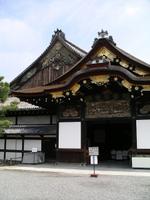 First stop for the morning was Nijo Castle. From the 17th to 19th centuries, Japan was ruled by a Shogun, or warlord. Although an emperor still existed, he was largely a figurehead since the Shogun controlled the military. The Shogun lived in Edo (now Tokyo) and the emperor lived in Kyoto. The Shogun would occasionally visit Kyoto to pay his respects to the emperor, though the gesture didn't mean much and not all of the men who were Shogun bothered to do it. While in Kyoto, the Shogun stayed at Nijo Castle. Although it's called a castle, it looked more like a stronghold to me - huge walls, quite a few buildings, but no tall donjon or keep. My two favorite features of Nijo Castle were the beautiful paintings on the interior walls (which we weren't allowed to photograph) and the nightengale floors. A nightengale floor is a floor designed to squeak loudly when someone walks across it. That way they can detect intruders quite easily. The castle's garden was also very nice and featured a pond with large stones and trees around it. Nijo Castle was my favorite part of the morning tour.
First stop for the morning was Nijo Castle. From the 17th to 19th centuries, Japan was ruled by a Shogun, or warlord. Although an emperor still existed, he was largely a figurehead since the Shogun controlled the military. The Shogun lived in Edo (now Tokyo) and the emperor lived in Kyoto. The Shogun would occasionally visit Kyoto to pay his respects to the emperor, though the gesture didn't mean much and not all of the men who were Shogun bothered to do it. While in Kyoto, the Shogun stayed at Nijo Castle. Although it's called a castle, it looked more like a stronghold to me - huge walls, quite a few buildings, but no tall donjon or keep. My two favorite features of Nijo Castle were the beautiful paintings on the interior walls (which we weren't allowed to photograph) and the nightengale floors. A nightengale floor is a floor designed to squeak loudly when someone walks across it. That way they can detect intruders quite easily. The castle's garden was also very nice and featured a pond with large stones and trees around it. Nijo Castle was my favorite part of the morning tour.
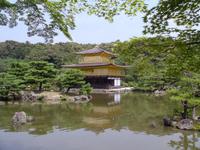 The second stop, which was a bit outside of town, was Kinkakuji, the Golden Pavilion. Kinkakuji is actually just one building on the grounds of Rokuonji, a zen buddhist temple. Rokuonji was originally the estate of a powerful relative of the Shogun, but he became a monk and turned his estate into a monastery. The golden pavilion was used as a tea house and although it was destroyed several times in the 14 and 1500's, it managed to survive unscathed until 1950, when it was burnt down by a young monk for reasons that will never be known. It was rebuilt five years later.
The second stop, which was a bit outside of town, was Kinkakuji, the Golden Pavilion. Kinkakuji is actually just one building on the grounds of Rokuonji, a zen buddhist temple. Rokuonji was originally the estate of a powerful relative of the Shogun, but he became a monk and turned his estate into a monastery. The golden pavilion was used as a tea house and although it was destroyed several times in the 14 and 1500's, it managed to survive unscathed until 1950, when it was burnt down by a young monk for reasons that will never be known. It was rebuilt five years later.Our third stop was the Kyoto Imperial Villa, which is where the emperor used to live. It is now mostly used to store certain ceremonial objects such as the imperial throne used for the enthronement ceremony for a new emperor. Part of it is still closed off in case someone from the imperial household does decide to visit, so security is pretty tight. Each tour group has a security guard assigned to them to watch for anyone straying away from the group. The buildings were pretty, but we didn't get to see any of the interiors, so it wasn't as interesting as Nijo Castle. The Villa's garden was very similar to Nijo Castle's garden.
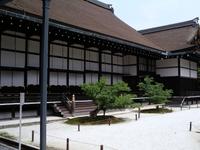
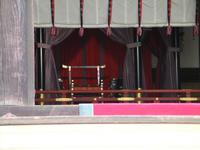
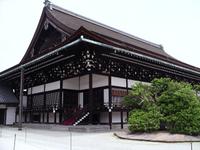

0 Comments:
Post a Comment
<< Home